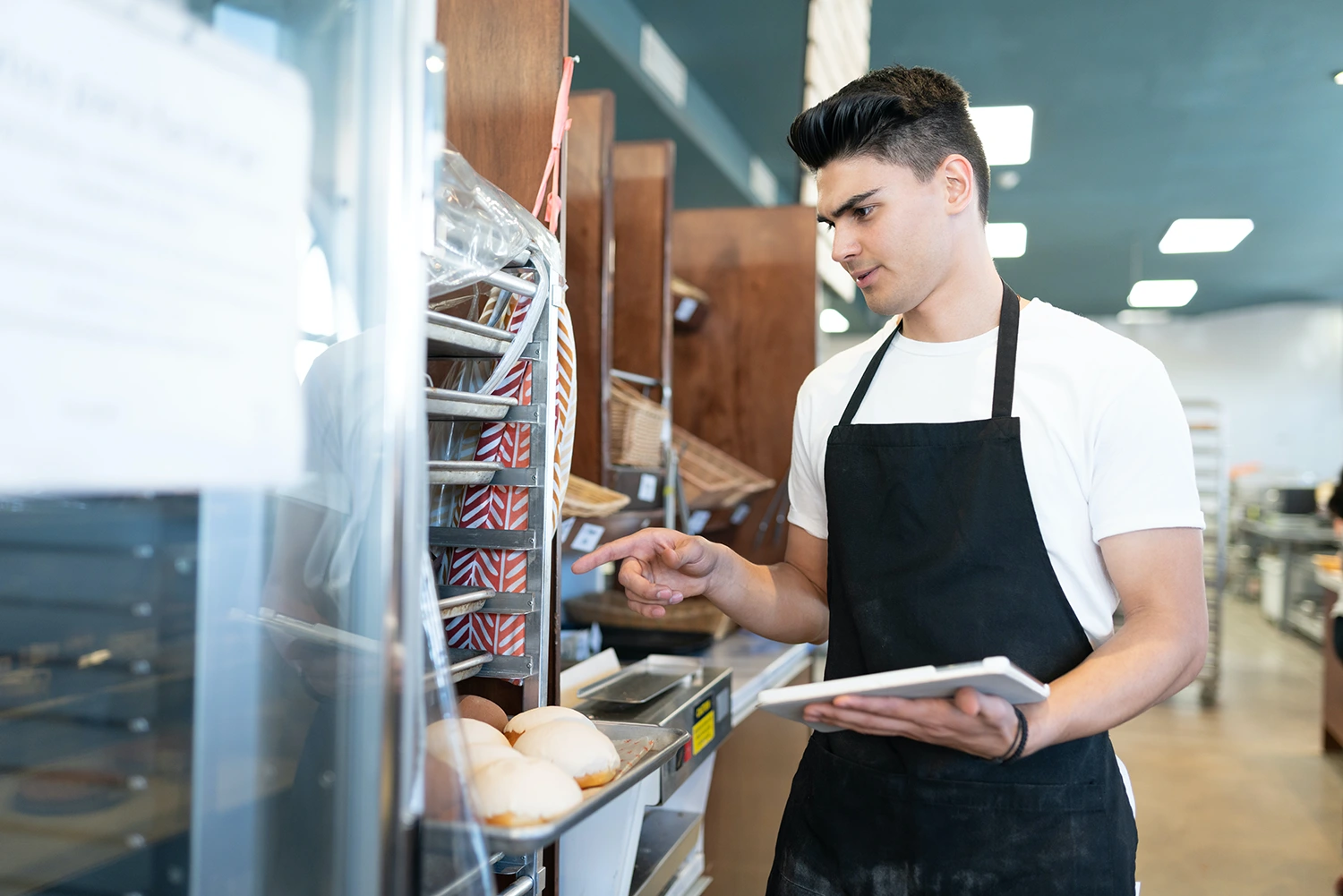Is the holiday season a blessing? Or a curse? For most restaurateurs, it’s both. On the blessing side, the holidays give you an opportunity to generate more revenue and attract new guests. On the curse side, they bring challenges and chaos that can test even the most seasoned operators.
We created this guide to help you survive and thrive in the upcoming holiday season. By proactively taking one, two, or more of the following steps—from using data and technology to creating cheer-added menus—you’ll be closer to experiencing a joyous, prosperous holiday season.
Ready? Let’s dive in.
1. Analyze last year’s performance
Start by visiting the ghosts of holidays past. If you have a data analytics tool, use it to understand customer behavior, peak hours, and popular menu items. For example, if your vegan options were a hit last year, it might be worth expanding that menu section this year.
Don’t just focus on the positives, though. Look at bottlenecks and areas where you fell short. Did customers complain about long waits? It may be time to rethink your table management strategy. Did your kitchen get jammed up? If your chefs struggled to keep up with orders, it might be time to streamline operations. Were there issues with wrong orders or bills? Mistakes like those frustrate customers, interrupt the flow of work, and pull staff away from service.
As Maya Angelou once said (and we humbly paraphrase), looking back at and facing sore spots means you never never experience them again.
“History, despite its wrenching pain, cannot be unlived, but if faced with courage, need not be lived again.” ~Maya Angelous
2. Craft a holiday menu
A holiday menu is more than just food; it’s a narrative. Consider Starbucks and its iconic Pumpkin Spice Latte. Its return each year isn’t just another drink on the menu; it’s an event that signals the arrival of fall. You can do the same by creating a limited-time holiday menu that tastes great and tells a story.
Imagine, for instance, “A Culinary Journey Through Winter Wonderland.” This menu could take diners on a journey through a winter landscape, with each course representing a different aspect or moment of a winter’s day. The experience could evoke the magic and nostalgia of winter holidays, from the first snowfall to cozy evenings by the fire.
The menu might offer a winter citrus salad to represent morning frost or cauliflower and truffle soup to represent the first snowfall. Seared scallops with saffron risotto might represent the winter sun, while herb-crusted lamb with root vegetables could symbolize snow-capped mountains.
Give guests a small card with each course to explain its place in the winter wonderland journey, adding layers of meaning and engagement to the dining experience.
With a menu like this, you’re not just serving food; you’re offering an immersive experience that reflects the season. It becomes an event people will talk about, share, and remember, much like Starbucks and its Pumpkin Spice Latte.
Bottom line? Let your culinary imagination run festive and free.
3. Staff up and train
The holiday season is a sprint, and you’ll need all hands on deck. Many restaurant operators often hire seasonal staff well before the holiday rush—and you can do the same. Consider hosting a dedicated hiring event well before the holiday season kicks off. Hiring events allow you to assess many candidates in a few hours. They also create a sense of urgency for applicants. You could also ask your current employees for referrals—people who’d be a good fit for your restaurant. Offer referral incentives to encourage your team to help with the hiring process.
But hiring is just the first step; comprehensive training is the next. Consider using role-playing exercises to prepare staff for common scenarios, such as handling a dissatisfied customer or managing a large group order. This proactive approach will help your team take the holiday pressure with grace.
Another idea is to create digital training materials that staff can complete independently. These materials, which cover everything from menu knowledge to company policies, ensure everyone gets the same training experience.
By being proactive in your hiring and training efforts, you’ll set the stage for a profitable, smooth-running, and enjoyable holiday season—for yourself, your staff, and your patrons.
4. Optimize your online presence
Your website or social media channels might be the first glimpse customers have of your restaurant. To prepare for the holidays, update your site and social channels now by adding holiday-themed visuals and promotions.
Tweak your SEO strategy, too, by focusing on holiday-related keywords. For instance, if you’re offering a Christmas brunch, target the keyword “Christmas brunch near me” to capture organic traffic and woo new customers. This tactic is especially good for bringing in tourists and visitors who are in your area for the holidays.
Another way to bolster your online presence ahead of the holidays is to prepare interactive social media campaigns. For instance, plan a “12 Days of Fine Holiday Dining” promotion where you unveil a new holiday special each day on Instagram. This tactic will keep your followers engaged while building anticipation for your holiday menu.
Now is also the time to ready your holiday email marketing campaigns. Write emails that pull in customer data to personalize holiday promotions and exclusive offers. For example, if you know a segment of your customer base comes to your restaurant for your desserts, write emails for that segment highlighting your holiday dessert menu.
Use these strategies now, and you’ll have a stronger online presence just in time for the holidays.
5. Use a reservation system
Long wait times are a major turn-off for hungry people, which is why many restaurants use reservation systems like OpenTable. These systems let customers book tables online so they have less time to wait and a better dining experience.
A reservation system is especially valuable during the busy holidays. You can use it to:
- Manage the surge in customers.
- Plan your staffing more accurately and have enough hands on deck during peak times.
- Open slots for booking special holiday events, like a Christmas Eve dinner or a New Year’s brunch, well in advance.
You can also use a reservation system to offer personalized holiday experiences. For example, you could allow customers to pre-select from your holiday menu when they make their reservations, giving you better control over inventory and preparation. Pre-selection also adds a touch of exclusivity and personalization to the dining experience.
And don’t forget about the goldmine of reservation system data, which will fuel next year’s holiday marketing efforts. If guests booked tables this year, you’ll be able to send them early-bird promotions or exclusive invites to next year’s events. Offers like those reward customer loyalty and help you fill tables fasters.
6. Stock up wisely
Managing inventory during the holiday season is a balancing act. While you don’t want to run out of popular items, you also want to avoid ending up with excess stock that goes to waste. To navigate this critical aspect of holiday preparation, consider using inventory management software that integrates with your POS system. This way, you can track sales as they’re happening, giving you time to adjust inventory before problems crop up.
Check inventory often, too, especially during the holiday season. Doing so allows you to spot discrepancies early. Also, keep the lines of communication with suppliers open to understand lead times and identify potential supply chain disruptions. And in the case of disruptions, it helps to have many baskets to hold your eggs. Partnering with multiple suppliers for key ingredients can be a lifesaver if one falls through.
Think beyond food, too. Stock up on other essentials like cutlery, cleaning supplies, and festive decor. These items contribute to the overall dining experience, so don’t overlook them.
By taking a strategic approach to inventory management, you’ll enjoy smoother operations during the holiday rush, giving you the mental space you need to focus on delivering an exceptional dining experience.
7. Market aggressively but precisely
The holiday season is a prime time to elevate your marketing game, but the key lies in being aggressive and precise. Start by using data analytics to segment your customer base so you can send targeted promotions. For example, offer a special holiday discount to patrons who dined with you during last year’s festive season. This action rewards loyalty and encourages repeat business.
Also, consider using limited-time offers (LTOs) to ignite a sense of urgency among your potential customers. During the holiday season, when the spirit of indulgence is in the air, LTOs can be particularly effective. Imagine offering a special holiday cocktail only for the week leading up to New Year’s Eve. Such an offer creates buzz and encourages patrons to visit before the offer expires.
Another LTO idea is to offer a discount on group reservations for customers who book before a specific date. This tactic fills your reservation book early and caters to the holiday trend of communal dining and celebrations. The key to a successful LTO is to make it unique and communicate its limited availability across all your marketing channels.
These approaches combined will boost your holiday revenue and lay the groundwork for customer relationships that last well into the new year.
8. Partner with local businesses
Photo by CHUTTERSNAP on Unsplash
Engaging with your community can also go a long way toward boosting your holiday sales. For instance, if you operate an Italian eatery, imagine partnering with a local wine shop for a holiday “wine and dine” package. You’d both attract more customers and foster a sense of community—a particularly effective win-win strategy during the holidays, when people are in the mood for communal experiences.
Another idea is to team up with local artists or craft shops to create unique holiday gift baskets that feature a mix of your restaurant’s specialties and the artisan’s products. Imagine a basket with your signature sauce, a handcrafted serving spoon, and a small recipe booklet. The collaboration would give patrons a unique gift option while cross-promoting local businesses.
Another avenue for partnership could be with local event spaces or entertainment venues. For instance, you could work with a nearby theater to offer a “dinner and a show” package. Patrons could enjoy a special pre-theater menu at your restaurant and then head to the theater with guaranteed good seats. The combination enhances the customer’s overall experience and can fill your restaurant during what might typically be slower hours.
Partnering with local businesses helps you to diversify your customer base and deepen your roots in the community. It also allows you to offer a holistic experience beyond just dining, giving your restaurant a starring role in the local holiday ecosystem.
9. Plan for the unplanned
Photo by Adam Winger on Unsplash
When your best-laid plans go awry, it’s time to pull out your restaurant contingency plans. Contingency plans—playbooks you can turn to quickly when things don’t go as expected—will save you a lot of headaches later on.
For instance, to plan for potential supply chain disruptions, you might forge agreements with multiple suppliers for your key ingredients. If one supplier can’t deliver, you have others you can turn to without missing a beat. You could also keep a small reserve of essential items that can tide you over for a short period.
In the case of staff shortages, consider cross-training your team members so they can work multiple roles. Doing so gives you the flexibility and readiness to adapt to unexpected situations by, for example, having a server who can also host or a line cook who can step in as a dishwasher. You could also recruit and maintain relationships with part-time or seasonal workers who’d be willing to fill in on short notice.
Is snow a regular visitor during your holiday season? Consider contracting with a local snow removal service so your parking lot and walkways get cleared promptly. You could also offer incentives, such as a slight discount, to encourage local patrons to brave the weather, making it worth their while and keeping your revenue flowing.
When you have well-documented and well-communicated contingency plans, you won’t be just reacting to challenges; you’ll be proactively managing them. This level of preparedness will minimize stress and instill confidence in your team because they’ll know you can handle whatever comes your way.
10. Embrace tech for holiday success
Photo by Robynne Hu on Unsplash
Technology is reshaping industries, and your restaurant shouldn’t be left behind, especially during the high-stakes holiday season. Using the latest technologies can give you a competitive edge, streamline operations, and enhance the customer experience, all crucial for holiday success.
Start by considering AI-driven customer service bots for handling reservations and basic inquiries. These bots can manage many interactions, freeing your human staff to focus on more complex customer service. For example, Google’s Contact Center AI can handle customer service tasks like answering frequently asked questions and assisting with reservations.
Next, think about advanced customer relationship management (CRM) systems that go beyond basic data storage. Modern CRMs can analyze customer behavior and preferences, enabling you to send hyper-targeted promotions. Salesforce offers a restaurant-specific CRM that can segment your customer base by dining history, average spend, and dish preferences. Imagine sending a personalized email to customers who ordered your pumpkin spice latte last year, inviting them back for this year’s new and improved version.
Also, consider implementing Internet of Things (IoT) devices in your kitchen for real-time equipment monitoring. Smart ovens, for instance, can alert you if they’re not reaching the correct temperatures, allowing you to address issues before they become problems that can affect food quality.
And don’t forget technology like the Stellar Menus Intelligent Menu Platform, which protects your margin and maximizes profits by monitoring the price of high-cost ingredients and alerting you when it’s time to change your prices. Making changes is easy, too, even in the middle of a service. With one click, changes automatically roll out to your website, mobile, and paper menus, and alerts fly to let you know to print new paper menus and your point-of-sale contact to update the POS system.
By integrating these technologies, you’ll keep up with the times and stay ahead of the curve. You’ll also be better able to manage the holiday rush, offer innovative and exceptional experiences, and position your restaurant as a forward thinker, setting the stage for success not just during the holidays but well into the future.
11. Bonus! Reflect and celebrate
Photo by Christine Jou on Unsplash
Finally, when the holiday rush is over, take time to take stock. Hold a holiday debrief or post-mortem with your team to discuss what went well and what didn’t. Debriefing can help you learn from your experiences, develop best practices, and prepare for future holiday seasons.
And be sure to celebrate your wins, no matter how small. Did you manage to serve a record number of customers? Did you get excellent customer reviews? Celebrate these victories with your team. After all, their hard work is what made it possible.
















